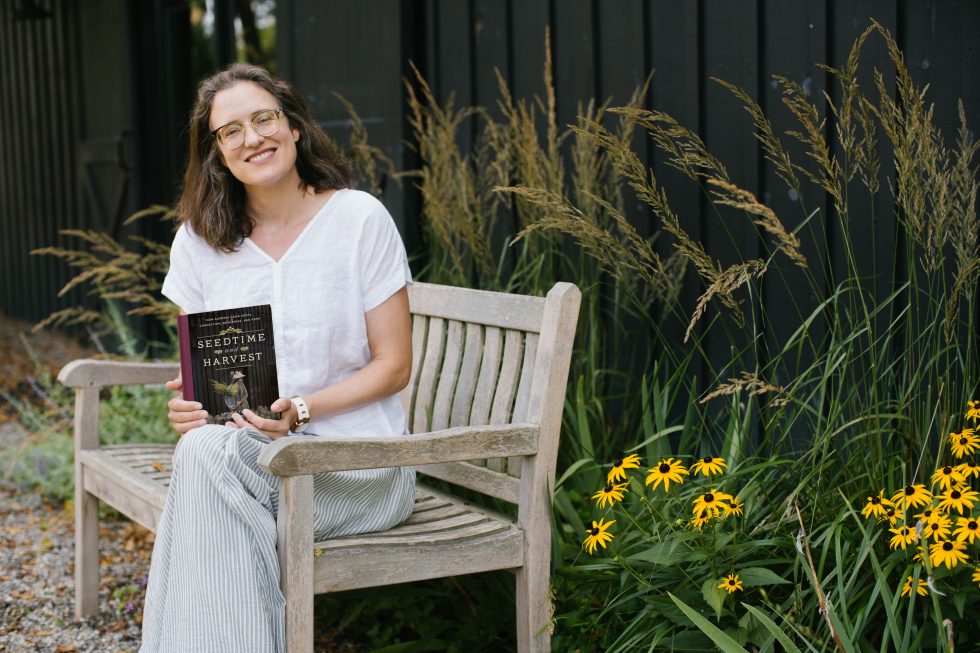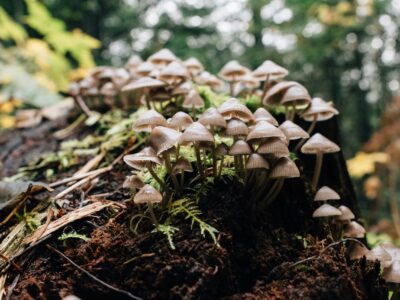Last fall, my children and I dug out the sod in part of our front yard to extend garden beds filled with groundcover in our quest to gradually eliminate the lawn (thanks, John Gidding!). In its place, I transplanted tiny starts of vinca minor (otherwise known as myrtle or periwinkle), pachysandra, and three fiddlehead ferns, along with a river birch and a couple of dappled willows.
And then winter came.
I know, rationally, that the fall is a great time to plant perennials and trees because plants can focus all of their energy on establishing roots during the winter months. But still, for months my garden bed looked dead. The birch looked dead. The willows looked dead. And where the lawn used to be there were only mulched leaves blown to cover the soil.
The earth and soil have warmed now, and I’ve been eyeing my front bed for weeks, annoyed at how many weeds I can see. It turns out that we didn’t pull up all of the grass. So yesterday, I spent part of the day getting up close and personal with the dirt in that patch of land, and between the dandelions and grass and other springy weeds whose seeds dispersed all over the place when I pulled them, I found vinca minor starts, everywhere, already spreading. And then, then! overnight, the fiddlehead ferns sprung up! And leaves have filled out on the willows, and branches are already growing taller on the birch, and it turns out that the life I started that looked like it had died off all winter actually persists and even spreads in my little garden bed.
This little 10×10 work-in-progress is my current delight, my garden bed filled with rich metaphors, ripe for the plucking.
Seedtime and Harvest: How Gardens Grow Roots, Connection, Wholeness, and Hope by Christie Purifoy
My little project is actually an extension of a much older gardener’s vision on our property, one of which I’m the benefactor. Whoever built and landscaped around our house decided not to do battle with the woods but instead to embrace the shade. When I work in the soil around our property, I am keenly aware that someone who loves this place also loves these plants, and I harvest daily the work of their hands. The mature Japanese maple growing in front of our main entrance and the towering maple that provides so much shade all came long before me. The rhododendron next to the garage that is as tall as our house now could only be this way because someone decided to plant a couple small bushes sometime in the last 70 years.
And now it’s all here, continuing to grow.
Image: Marcus Spiske
Whether we’re aware of it or not, plants and gardening connect us to each other.
I have been reading Christie Purifoy’s beautiful book, Seedtime and Harvest while all of this has been going on in my front yard, and I can think of no better companion while the work I did last fall comes back to life without any help from me.
Purifoy writes in the introduction, “Your pots of herbs on the windowsill may seem isolated and small, but they are a link with your neighbor’s tomato bed, which is a link with the community garden, and a link to the forest preserve, the botanical garden, the organic farm—all of them joining up to wind the earth round in green ribbons of life. From seedtime to harvest and back again, the reconciling work of a garden is never finished, always, ongoing, and, in every season, eager for us to join in and receive the more that is our heart’s desire.”
That line, “From seedtime to harvest,” which inspires the title of Purifoy’s book, comes from Genesis 8:22, “While the earth remains, seedtime and harvest, cold and heat, summer and winter, day and night, shall not cease.”
It is the truth; the work of the garden doesn’t stop once the leaves fall and the vines die back. Life persists in the soil, underground. Each season is given to us for its purpose, sometimes to put down roots, sometimes to stretch and grow, sometimes to plant, sometimes to harvest.
Purifoy’s book blends lyrical reflections on our garden lives with practical advice about types of plants and ways of gardening, and every page is paired with stunning images from the garden to inspire and celebrate the beauty of creation. The book is organized into four parts—how gardens grow roots, how gardens grow connection, how gardens grow wholeness, and how gardens grow hope.
I connected with so much of Purifoy’s book, but the very first chapter hooked me right away—this is a woman who gets me, I thought. “The Ghost in My Garden” reflects on Dorothy, the woman who planted heirloom roses generations before Christie and her family moved into the Victorian farmhouse in southeastern Pennsylvania. I thought of Purifoy’s “ghost” while I weeded around my infant groundcover transplants, both because some “Dorothy” started these beds at my home long before I came along and also because, like Purifoy, I am a transplant to this property myself, the benefactor of former gardeners.
As much as we’d like to deny it, we are all inextricably tied to the past and connected to each other. Gardening reminds us of this truth and re-roots us, re-grounds us, and reconnects us in a very tangible way to each other, to our planet, and to our history.
My effort to get rid of our lawn is rooted in several desires—first, to try to return more and more of our property to a more natural landscape; second, to rely less on lawn mowing; third, to grow more plants we can eat; fourth, to nurture beauty; fifth, to live out of abundance and share with our neighbors, both human and non-human; sixth, to spend more time creating and cultivating a space of sanctuary outdoors.
Purifoy reflects on some of these same urges in her chapter on “The Art of Wildness”:
Because the world has changed (or rather, because we have changed the world), our culture of gardening must change. Even our definition of sanctuary must shift. The word sanctuary comes from a Latin word for a container used to keep holy objects or cherished things, even cherished people. Today, then, our gardens cannot function as true sanctuaries if we tend them in ways that keep life out. If we cherish birds and bees and butterflies—and children!—as well as green leaves and flowers and waving grasses, then our gardens should be containers for all these. In so many ways the world we have made has become hostile to life. When we garden, we have the opportunity to create places where life is nurtured. If we allow our gardens to become a little messier, a little wilder, then paradoxically we’ll find it that much easier to discover what the poet Wendell Berry has called the ‘peace of wild things.’ And where there is peace, there is hope.
That is, ultimately, the same roots I hope to nurture, in my gardens and in my life—peace and hope. Perhaps alongside Purifoy, we can all embrace a little more space to nurture life that is a little messy and a little wild in pursuit of growing peace and hope.





 Copyright
2024
Root and Vine
Copyright
2024
Root and Vine